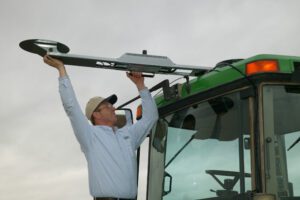Real-Time Kinematic (RTK) AutoSteer
Inducted In: 2006, Industrial Productivity/Manufacturing Technology
Improved Global Positioning System (GPS) technology developed to help the Gravity B Probe test Einstein’s theories has found its way into farming here on Earth. This technology called RealTime Kinematic (RTK) GPS, provided the tools to develop the first auto steered tractor.
Today RTK AutoSteer technology robotically controls farm tractors to ensure straight, repeatable crop rows to within 2 cm.
This accuracy dramatically increases crop yields; reduces environmental pollution, and lowers operating costs. AutoSteer is also helping enable future technologies, such as crop trace-ability to improve food supply security. Population growth, drought, erosion and pest pressure increasingly threaten food supplies. Space technology like RTK AutoSteer is helping ensure there is plenty for everyone here on Earth.
Related Technologies

Beowulf Computing Cluster
Inducted In: Communications Technology, Computer Technology, Featured, Industrial Productivity/Manufacturing Technology
A Beowulf Computing Cluster is a grouping of off-the-shelf computer hardware networked together with fast communication software. The resulting parallel processing power of the collection generates processing speeds faster than most super-computer systems used for complex processing – at a…

CubeSats
Inducted In: Computer Technology, Featured, Industrial Productivity/Manufacturing Technology
The origin story of the CubeSat idea is clear-cut and well-known. It was conceived by two engineering professors as a teaching tool for students to get hands-on experience with satellite functionality. In the 1990’s Professor Robert Twiggs was teaching engineering…

Protective Coating for Ceramic Materials
Inducted In: Featured, Industrial Productivity/Manufacturing Technology
Researchers at Ames had devised a silicon-based compound as part of the development of the X-33 and X-34 prototype planes. These planes were projected to fly at 15 times the speed of sound. The friction from these super-sonic speeds would…

